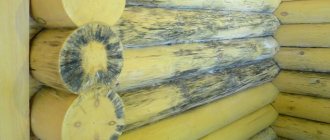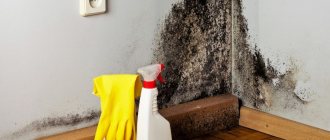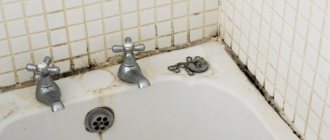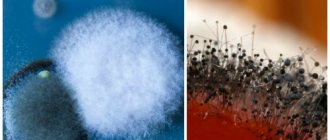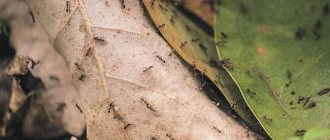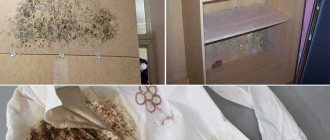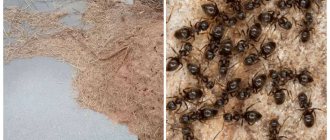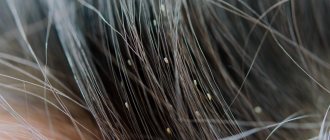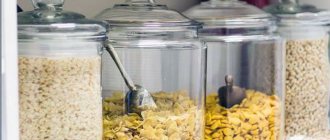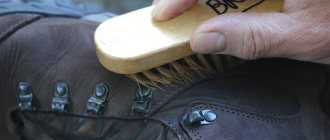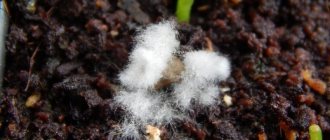| Place | Name | Characteristics in the rating |
| Top 10 best remedies for mold on walls |
| 1 | Savo | Best quality. Does not require mechanical cleaning of the surface from mold film |
| 2 | Dali | Does not contain chlorine and its derivatives |
| 3 | Sazi Wepost Luxe | Effective protection against mold and moisture |
| 4 | Fongifluid Alpa | Offered to the buyer in a ready-to-use form |
| 5 | AMSS | The best instant cleansing of the affected surface |
| 6 | Olymp-stop mold | Creates long-lasting protection against mold |
| 7 | Abedis 06 | Approved for use in children's institutions |
| 8 | Neomid Bio Repair | The best ratio of price and quality. Environmentally friendly |
| 9 | Belinka | Does not contain bleaching agents, does not change the color of the surface |
| 10 | Biotol spray | Recommended for restoration work |
Mold on the walls is a microscopic fungus that harms interior items and the health of the occupants of the premises. A room with fungus becomes dangerous to live in due to spores of microorganisms in the air and entering the body when inhaled. There they settle, causing respiratory tract infections. The systematic entry of fungal spores into the body sharply weakens the immune system and contributes to the appearance of signs of asthma, suffocation, and rapid heartbeat. It is not always possible to establish a connection between weak immunity and fungus on the walls, since patients do not attach importance to this, and doctors do not ask such questions. Mold spreads to furniture, clothing, and carpeting. You have to spend money on new things and clean more often.
Fighting fungus is not easy, but the chemical industry offers many products that successfully solve this problem. The choice is preceded by identifying the causes of this phenomenon. The main ones are: high humidity, insufficient ventilation, the presence of voids in the walls, sudden temperature changes inside and outside the room. After identifying the cause, a means is selected to remove blackness from surfaces. To improve ventilation, it is enough to purchase a forced air exchange unit; you can seal the voids with special building materials, but not all causes can be eliminated mechanically. There are chemicals, the best of which are presented below.
It is necessary to eliminate favorable conditions for the formation of fungus
- Set up ventilation. If there is a problem with air circulation in the room, you need to ensure high-quality air ventilation by installing forced air supply devices.
- Warm up and dry the room. If new mold colonies constantly appear in the problem room, it needs to be dried using a heat gun.
- Checking the attic and basement. If there is dampness in these rooms, it is necessary to check the foundation and roof of the building. Establish waterproofing and vapor barrier in the premises.
- Exposure to ultraviolet radiation. If it is possible to ensure the penetration of sunlight into the room, then you need to take advantage of it. Mold does not tolerate exposure to sunlight well.
Simply put, you need to take all measures to reduce the humidity in the room.
We carry out prevention
Agree, it is always easier and cheaper not to eliminate the problem, but to prevent it. Therefore, it is necessary to periodically prevent the appearance of black mold in the house. Such measures include:
- regular ventilation;
- checking the proper operation of ventilation;
- checking the premises for fistulas, leaks, cracks and eliminating them;
- treating all existing building materials with special antiseptic agents (before repairs);
- eliminating holes and cracks in frames, if any;
- ventilation of the bathroom.
Fans for the bathroom
Important! Don't dry things in the bathroom!
Black mold is a dangerous enemy of humans, causing great harm to health. It is possible and necessary to fight it, but it is best not to start the problem and start solving it at a very early stage. Then victory will definitely be on your side.
Types of primers by purpose
Since mold can affect surfaces made of various materials, it is necessary to treat floors and walls made of concrete, wood, and brick. The primer is applied to drywall or plaster. Compositions are produced for each type of material.
Based on their purpose, antifungal primers come in the following types:
- Regular. Used to prevent mold formation.
- Deep penetration antifungal primer. Used to treat surfaces affected by fungus. This impregnation destroys spores located inside the material and is characterized by a long-lasting effect.
Antifungal drugs for professional treatment
These products can be applied independently, but they give the best results if you contact disinfection service workers. They are designed to be sprayed with fog or hot steam generators and can withstand high humidity levels. If you are looking for how to get rid of mold on walls throughout your home, professional-grade products are your choice.
Belinka
A Slovenian-made antifungal solution is designed to combat most known parasitic fungi. Harmless for porous building surfaces (concrete, gypsum). Unlike many other semi-professional products, it remains effective when sprayed in rooms with high humidity levels (up to 80%). The formula cleans and disinfects without bleaching, which is ideal when working with colored walls. “Belinka” is used for repairs and restoration work, as well as to preserve the finish in houses contaminated with mold.
Do not use undiluted solution. To remove mold, prepare a mixture of the drug and water in proportions of 1:4. After preparation, Belinka is distributed through industrial steam generators, released into the air with compact sprayers, or applied with brushes directly to the affected area. Then wait until the solution dries and wash off the dead remnants of the fungus with a hot jet under pressure.
Abedis
A guanidine-based product destroys mold deposits and protects surfaces from re-infection. Works as an absolute antiseptic, destroying almost all potentially dangerous microorganisms. Used to combat old mold damage, completely removes black and brown marks from the walls.
The active emulsion is diluted with water in a ratio of 1:2, then either applied to the wall with a wide roller or sprayed with a steam generator. After a day, the remaining contaminants are washed off with a powerful stream of water. Repeated treatment is carried out no earlier than after 2-3 days.
Abedis is recommended for preventive treatment of houses with small children and pets. It is mixed with paints, varnishes and other building materials to long-term protect surfaces from destructive fungi. This product is recommended for total treatment of ceilings and walls in apartments with a high mold density. Even if the fungus returns to rooms through the air conditioner or cracks in the house, the formula will provide protection against recurrence.
Dali
Russian antifungal drug for destroying large accumulations of mold, bacteria, and moss. Designed to completely remove harmful microorganisms from the ceiling and walls. Unlike softer products, it does not require preliminary preparation of the walls. There is no need to level the surface, remove wallpaper or plaster: the Dali will seep under the external materials. This helps combat mold in older homes, where spores are hidden behind many years of layers of decor.
The solution does not contain chlorine and is suitable for any wooden, brick, concrete or plasterboard surfaces. You can apply it in any convenient way (brush, rollers, spray), however, for total control of mold, a fog generator is recommended. Depending on the degree of damage, the drug is left on the surfaces for 1 to 2 days, then the dirt is removed with a stiff abrasive brush. At each stage of work, respirators are used, since the product has a pronounced chemical odor.
What types of mold exist, and what harm do they cause to human health?
There is a huge variety of molds. Each of them poses a danger to human health. By constantly staying in a house infected with fungus, you can acquire chronic diseases.
The most common types of mold that often “settle” in a residential building:
Black. Most often this is the type that appears on the walls. Can appear on any type of surface. Concrete, plaster, wallpaper, paint, and wood are equally easily affected.
Wall affected by black rot
Why it is dangerous: with constant exposure to the human body, it can cause dizziness, sleep disturbance, and insomnia. Headaches are common, and body temperature may rise. The worst option is dermatitis or the development of diseases of the respiratory system: bronchitis, asthma, pneumonia and even lung cancer.
White. It appears in the apartment mainly in flower pots. Appears on walls in rare cases. Excessive watering or the application of certain fertilizers can provoke the development of fungus.
Wall affected by white rot
Why it’s dangerous: less harmful option than the previous one. But if you do not fight this “pest,” it can provoke the development of allergic reactions in humans.
Blue mold. Settling in wood fiber, it affects wooden surfaces: frames, parquet, wooden furniture. Under their influence, the tree acquires an unattractive bluish-gray tint.
Tree affected by blue rot
Why it is dangerous: the fungus destroys the paintwork and forms microscopic channels in the wood. Water gets into them, increasing the moisture content of the wood. This creates more favorable conditions for mold to grow.
Green. Most often it develops on food products. It can often be seen on bread. Occasionally it develops on building materials, for example, on brick.
Wall affected by green rot
Why it is dangerous: fungal spores, once in the human body, are digested by the gastrointestinal tract and excreted from the body. If the immune system is weak, the spores enter the bloodstream and cause serious illness. Among them: liver cirrhosis, bronchial asthma, benign and malignant formations.
Mold rotting. Like blue rot, it affects wooden surfaces. A characteristic sign that rotting mold is developing in wood is a gray or brown tint to the top layer of wood products.
Wood rotting
Why it is dangerous: after exposure to this fungus, the wood becomes lighter and becomes covered with cracks. In the most advanced cases, a complete replacement of wooden surfaces is required: frames, floor boards, parquet, furniture.
Surface preparation
Before you start treating materials with an antiseptic, you should make sure that there is no fungus. If mold has already spread to the walls, it must be removed. Whitening or bleach will help, applied to the surface with a stiff brush.
Priming can only be done after the disinfectant solution has completely dried. Before this, the material must be heated with a hair dryer. This operation will allow the antifungal agent to penetrate deeper into the surface and prolong its effect.
Important! Only dry and clean material that does not peel off should be processed.
After finishing the treatment, it is necessary to disinfect all working tools. This procedure will prevent mold from spreading to other areas.
What is the danger?
At first glance, mold may seem unpleasant but harmless, but this is not the case. Black mold can cause serious harm to humans, including death. If you live near mold fungi for a long time, the following health problems may appear:
- Dermatitis and other skin diseases, the nature of which is difficult to determine, which means they are difficult to treat.
- Diseases of the respiratory system, such as asthma, bronchitis, pneumonia.
- Diseases of the musculoskeletal system, as mold spores negatively affect human joints.
- Allergic reactions up to Quincke's edema.
- Once inside the body, black mold can cause disorders in the functioning of internal organs, especially the stomach and intestines.
When living for a long time in a home with mold, a person becomes irritable, prone to depression, weakness in the body, and frequent headaches. With a high concentration of spores of the fungus of the genus Aspergillus, intoxication of the body can occur.
Elderly people and young children are most vulnerable to mold because their immune systems are not strong enough to fight mold spores on their own.
Alternative remedies for mold control
New generation household or professional chemicals are the best choice for exterminating mold. But if you do not have access to quality products, or you are unhappy with the results, you can try other methods of removing mold.
Smoke bombs against mold spores
A small smoke bomb will free the basement or cellar from mold and mildew and remove spores and harmful bacteria from the greenhouse. In Russia, “Climate” smoke bombs are more often used, but you can try bombs from other manufacturers, since their composition is similar (55-80% sulfur). Differences in additional components are associated with the proprietary composition of insecticides, which manufacturers add to checkers for reasons of versatility.
Smoke bombs effectively disinfect air and surfaces. In the form of smoke, sulfur, a powerful fungicide, penetrates into the smallest cracks, leaving mold no chance. Why don’t they smoke residential or domestic premises with checkers? Main reasons:
- Increased fire danger. A smoke bomb is set on fire to fill the air with combustion products. This will be dangerous in an apartment, not to mention that the dense smoke will set off a fire alarm.
- Demanding requirements for materials. For metals, sulfur is more dangerous than any aggressive household chemical. To fumigate a room, you will either have to remove all metal objects or isolate them. The equipment also does not tolerate contact with sulfur smoke.
- Difficulties with ventilation. Rooms that you use regularly will become saturated with smoke and a specific smell. It is easy to ventilate rooms after chemical fog, but after smoke it is long and difficult.
Experts recommend resorting to checkers only if you are fighting mold in non-residential premises or areas of a residential building that are cut off from other rooms. Otherwise, the smoke will inevitably end up where it was not expected and cause irreparable material damage.
Table vinegar
Although this ingredient is not intended to combat microorganisms, it is often recommended in response to questions about how to get rid of mold in an apartment. A pungent odor is a small drawback compared to low toxicity and quick results with a minimal area of contamination.
To remove dark stains from bathroom tiles or kitchen wallpaper, fill a spray bottle with table vinegar. It is not necessary to dilute it, since the product is low-toxic. Thoroughly treat stains with vinegar, rinse after 25-30 minutes and ventilate the room thoroughly.
Attention: if the area of infection is more than 0.5 m2, it is not recommended to use table vinegar. The strong smell of vinegar provokes headaches, but the substance is still less effective than specialized products.
Baking soda
Housewives use regular baking soda against mold or mildew in the bathroom. Contaminated areas are generously sprinkled with soda, then sprinkled with an activator - water or vinegar (for maximum effect). The liquid triggers a chemical reaction, during which foam is actively formed. Wait until the mixture stops sizzling and then gently wipe the surfaces with a clean cloth or sponge.
This method is attractive due to its accessibility, but you need to take into account that it is not suitable for all materials. Wood can be treated with soda, especially if you complete the cleaning with a “nutritious” wipe of water and oil (1-2 teaspoons per cup). But decorative finishing materials or beautiful vintage wallpaper can deteriorate from such aggressive care.
To clean the surface clean with soda, you will need from 3 to 5-7 maintenance sessions, which is labor-intensive compared to other methods. It is also worth considering that disinfection with soda will not be complete without vinegar. And if you already use vinegar, is it really necessary to add baking soda to the mix? Vinegar wipes do not hiss, but they fight mold just as well as soda, and are much less dangerous for sensitive surfaces.
White
A concentrated chlorine solution quickly attacks the fungus and cleans any surface. Bleaching acts as both a cleaner and a disinfectant, killing bacteria and other pathogens. This is a cheap and cheerful solution for eliminating small pockets of mold, designed for durable surfaces.
Whiteness is recommended as the first remedy for mold in the house. Its low price makes it easier to test the fungus for its tendency to return. If after rinsing with chlorine the contaminants disappear and do not appear again, you have successfully found the main source. The return of dark spots will indicate the need for a more serious fight, possibly with preventative medications.
Before using “Whiteness”, read the instructions carefully. The undiluted product is not suitable for all surfaces. It also makes sense to pour the solution into a spray bottle, since stores usually offer bleach in a package without a spray bottle.
